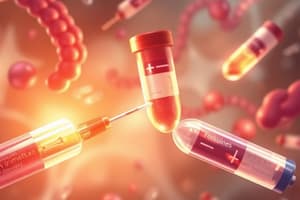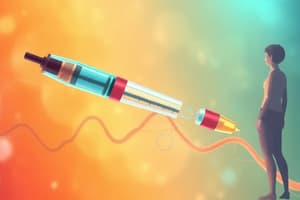Podcast
Questions and Answers
A patient newly diagnosed with Type 1 Diabetes Mellitus (T1DM) asks why they need insulin injections for life. What is the most accurate explanation you can provide?
A patient newly diagnosed with Type 1 Diabetes Mellitus (T1DM) asks why they need insulin injections for life. What is the most accurate explanation you can provide?
- T1DM results in increased glucose absorption in the intestines, and injected insulin is required to counteract this effect.
- T1DM is characterized by autoimmune destruction of beta cells in the pancreas, leading to an absolute insulin deficiency. (correct)
- The liver in T1DM patients overproduces glucose, and injected insulin helps to suppress this excess production.
- In T1DM, the body becomes resistant to the insulin it produces, necessitating higher doses via injection.
A patient with Type 2 Diabetes Mellitus (T2DM) is prescribed metformin. Which pathophysiological mechanism is most directly targeted by this medication?
A patient with Type 2 Diabetes Mellitus (T2DM) is prescribed metformin. Which pathophysiological mechanism is most directly targeted by this medication?
- Exaggerated postprandial glucagon secretion.
- Autoimmune destruction of pancreatic beta cells.
- Increased insulin sensitivity in peripheral tissues. (correct)
- Renal glucose reabsorption.
Which factor differentiates the administration of Humulin R from Humalog?
Which factor differentiates the administration of Humulin R from Humalog?
- Humulin R is typically administered intravenously, while Humalog is given subcutaneously.
- Humulin R should administered 30 minutes before a meal, whereas Humalog should be administered just before a meal. (correct)
- Humulin R has a peak between 1-2 hours., whereas Humalog has a peak between 2-4 hours.
- Humulin R has a duration of approximately 24 hours, while Humalog has a duration of 3-5 hours.
A nurse is educating a patient on the appropriate use of NPH insulin. What key point should the nurse emphasize regarding the nature and administration of this insulin type?
A nurse is educating a patient on the appropriate use of NPH insulin. What key point should the nurse emphasize regarding the nature and administration of this insulin type?
A patient with diabetes is prescribed insulin glargine (Lantus). What is the most important instruction to provide regarding its administration?
A patient with diabetes is prescribed insulin glargine (Lantus). What is the most important instruction to provide regarding its administration?
A pregnant woman is diagnosed with Gestational Diabetes Mellitus (GDM). What is the primary cause of hyperglycemia in this condition?
A pregnant woman is diagnosed with Gestational Diabetes Mellitus (GDM). What is the primary cause of hyperglycemia in this condition?
A patient with diabetes experiences a hypoglycemic episode. After administering 15 grams of fast-acting carbohydrates, how long should the nurse wait before rechecking the patient's blood glucose level?
A patient with diabetes experiences a hypoglycemic episode. After administering 15 grams of fast-acting carbohydrates, how long should the nurse wait before rechecking the patient's blood glucose level?
Which of the following complications is most closely associated with chronic, poorly controlled diabetes?
Which of the following complications is most closely associated with chronic, poorly controlled diabetes?
A patient with diabetes is admitted to the hospital with Diabetic Ketoacidosis (DKA). What is the initial priority nursing intervention?
A patient with diabetes is admitted to the hospital with Diabetic Ketoacidosis (DKA). What is the initial priority nursing intervention?
During a diabetes education session, what foot care instruction is most important to emphasize to prevent complications?
During a diabetes education session, what foot care instruction is most important to emphasize to prevent complications?
Which statement best describes the pathophysiology of Type 2 Diabetes Mellitus (T2DM)?
Which statement best describes the pathophysiology of Type 2 Diabetes Mellitus (T2DM)?
A healthcare provider is teaching a patient about 'sick day rules' for diabetes management. Which key instruction should be included?
A healthcare provider is teaching a patient about 'sick day rules' for diabetes management. Which key instruction should be included?
A patient with diabetes is being discharged from the hospital. Which statement indicates the patient understands warning signs that need immediate attention?
A patient with diabetes is being discharged from the hospital. Which statement indicates the patient understands warning signs that need immediate attention?
Which type of insulin is most appropriate for covering the immediate carbohydrate intake of a meal?
Which type of insulin is most appropriate for covering the immediate carbohydrate intake of a meal?
A patient is prescribed both insulin glargine and insulin lispro. How should the nurse instruct the patient to administer these insulins?
A patient is prescribed both insulin glargine and insulin lispro. How should the nurse instruct the patient to administer these insulins?
A patient with diabetes asks about the best way to monitor their blood glucose control at home. What is the most accurate recommendation?
A patient with diabetes asks about the best way to monitor their blood glucose control at home. What is the most accurate recommendation?
What is the primary goal of nutritional management in patients with diabetes?
What is the primary goal of nutritional management in patients with diabetes?
When educating a patient on exercise and diabetes management, what key point should the nurse emphasize?
When educating a patient on exercise and diabetes management, what key point should the nurse emphasize?
A patient reports consistently elevated blood glucose levels in the morning, despite adhering to their prescribed insulin regimen. What phenomenon might be occurring?
A patient reports consistently elevated blood glucose levels in the morning, despite adhering to their prescribed insulin regimen. What phenomenon might be occurring?
Which long-term complication of diabetes is often characterized by nerve damage, leading to numbness, tingling, and pain, particularly in the extremities?
Which long-term complication of diabetes is often characterized by nerve damage, leading to numbness, tingling, and pain, particularly in the extremities?
Flashcards
Rapid-Acting Insulin
Rapid-Acting Insulin
Insulin that starts working quickly, usually within 10-15 minutes. Examples include Insulin lispro (Humalog) and Insulin aspart (NovoLog).
Short-Acting Insulin
Short-Acting Insulin
Insulin that takes about 30-60 minutes to start working. An example is Regular insulin (Humulin R, Novolin R).
Intermediate-Acting Insulin
Intermediate-Acting Insulin
Insulin that has a longer duration of action, typically lasting 12-18 hours. Examples include NPH insulin (Humulin N, Novolin N).
Long-Acting Insulin
Long-Acting Insulin
Signup and view all the flashcards
Type 1 Diabetes (T1DM)
Type 1 Diabetes (T1DM)
Signup and view all the flashcards
Type 2 Diabetes (T2DM)
Type 2 Diabetes (T2DM)
Signup and view all the flashcards
Gestational Diabetes (GDM)
Gestational Diabetes (GDM)
Signup and view all the flashcards
Diabetes Assessment
Diabetes Assessment
Signup and view all the flashcards
Diabetes Medications: Teaching
Diabetes Medications: Teaching
Signup and view all the flashcards
Diabetes Nutrition
Diabetes Nutrition
Signup and view all the flashcards
Diabetes Exercise
Diabetes Exercise
Signup and view all the flashcards
Hypoglycemia Treatment
Hypoglycemia Treatment
Signup and view all the flashcards
DKA/HHS Interventions
DKA/HHS Interventions
Signup and view all the flashcards
Diabetes Education
Diabetes Education
Signup and view all the flashcards
Patient Teaching: Key areas
Patient Teaching: Key areas
Signup and view all the flashcards
Diabetes Complications
Diabetes Complications
Signup and view all the flashcards
Study Notes
Types of Insulin
- Rapid-acting insulin examples include insulin lispro (Humalog), insulin aspart (NovoLog), and insulin glulisine (Apidra).
- Rapid-acting insulin has an onset of 10-15 minutes, peaks in 1-2 hours, and lasts for 3-5 hours and should be taken before meals while monitoring for hypoglycemia.
- Short-acting insulin, such as regular insulin (Humulin R, Novolin R), begins working in 30-60 minutes, peaks in 2-4 hours, and lasts for 5-8 hours.
- Short-acting insulin is administered intravenously/subcutaneously 30 minutes before meals.
- Intermediate-acting insulin like NPH insulin (Humulin N, Novolin N) starts working in 1-2 hours, peaks in 4-12 hours, and lasts for 12-18 hours.
- NPH insulin is cloudy and should be rolled to mix, it is often taken twice daily (BID).
- Long-acting insulins include insulin glargine (Lantus) and insulin detemir (Levemir).
- Long-acting insulin begins working in 1-2 hours, has a minimal peak, and lasts approximately 24 hours and should be taken at the same time each day and not mixed.
Types of Diabetes
- Type 1 Diabetes (T1DM) is caused by autoimmune beta-cell destruction and requires lifelong insulin, carbohydrate counting, and blood glucose monitoring.
- Type 2 Diabetes (T2DM) results from insulin resistance and beta-cell dysfunction.
- Risk factors for T2DM include obesity, sedentary lifestyle, and family history.
- Management of T2DM includes lifestyle changes, oral medications, and insulin as needed.
- Gestational Diabetes (GDM) is caused by hormonal insulin resistance during pregnancy, it is managed through diet, exercise, and insulin if needed.
- Other specific types of diabetes include MODY, LADA, and those caused secondarily by factors like steroids or pancreatitis.
Nursing Care for Diabetes
- Assessment involves monitoring blood glucose, assessing symptoms, and reviewing patient adherence to treatment plans.
- Nursing interventions include educating patients on proper medication use and side effects.
- Nutritional guidance includes carbohydrate counting and maintaining a balanced diet.
- Promoting exercise and monitoring blood glucose levels are important interventions and to treat hypoglycemia, give 15g of carbs and recheck in 15 minutes.
- For DKA/HHS, monitor hydration and administer insulin/fluids.
- Education includes monitoring blood glucose, sick day rules, and foot care.
Patient Teaching
- Instruct patients to inspect their feet daily, understand sick day insulin use, and recognize warning signs.
- Potential complications of diabetes include eye, kidney, nerve, and cardiovascular diseases.
Studying That Suits You
Use AI to generate personalized quizzes and flashcards to suit your learning preferences.




